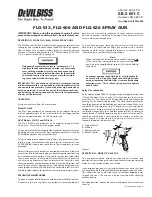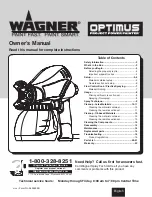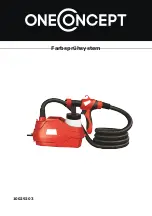
possible. If a wire or hard instrument is used, extreme care must
be used to prevent scratching or burring of the holes which will
cause a distorted spray pattern.
To clean fluid passages, remove excess material at source, then
flush with a suitable solvent. Wipe gun exterior with a solvent
dampened cloth. Never completely immerse in solvent as this
is detrimental to the lubricants and packings.
Note
When replacing the fluid tip or fluid needle, replace both
at the same time. Using worn parts can cause fluid leak-
age. Using the supplied fluid tip tool (16), tighten fluid tip
hand tight.
To prevent damage to the fluid tip (3) or fluid needle (6),
be sure to either 1) pull the trigger and hold while tight-
ening or loosening the fluid tip or 2) remove fluid needle
adjusting screw (15) to relieve spring pressure against
needle collar.
Spray Gun Lubrication
Daily, apply a drop of SSL-10 spray gun lube at trigger bearing stud
(11) and the stem of the air valve (17) where it enters the air valve
assembly (21). The shank of the fluid needle (6) where it enters the
packing nut (8) should also be oiled. The fluid needle packing (9)
should be kept soft and pliable by periodic lubrication. Make sure
the baffle (5) and retaining ring (1) threads are clean and free of
foreign matter. Before assembling retaining ring to baffle, clean
the threads thoroughly, then add two drops of SSL-10 spray gun
lube to threads. The fluid needle spring (14) and air valve spring (18)
should be coated with a very light grease, making sure that any
excess grease will not clog the air passages. For best results,
lubricate the points indicated, daily.
A. Trigger Points
B. Packing
C. Adjusting Valves
D. Baffle Threads
Figure 1
DESCRIPTION - MODEL TGC-545 CUP
This one quart capacity drip free suction cup has a unique, two
position valve which permits selection of either a drip free spraying
mode or a conventional open vent mode.
In the drip free position, air is directed through the vent in the lid to
a channel beneath the lid gasket before entering the cup at the valve.
This allows the cup to be tilted when full without dripping paint
through the vent. The cup can also be inverted while spraying
without leaking.
The open position isolates the channel and opens a direct vent into
the cup.
(Continued on page 3)
SERVICE BULLETIN
SB-2-601-C
Replaces SB-2-601-B
Gun Repair Kit FLG-480
IMPORTANT: Before using this equipment, read all safety
precautions on page 2 and instructions. Keep for future use.
DESCRIPTION - MODEL FLG-606 & FLG-626 SPRAY GUNS
The FLG-606 and FLG-626 are light weight, general purpose suction
feed spray guns for both conventional and HVLP spraying applica-
tions suitable for use with a wide variety of common coating
materials. These models include the TGC-545 suction cup. The FLG-
513 is a pressure feed HVLP spray gun.
Halogenated hydrocarbon solvents - for example; 1, 1, 1-
trichloroethane and methylene chloride - can chemically
react with the aluminum in this gun and cause an explo-
sion hazard. Read the label or data sheet for the material
you intend to spray. Do not use spray materials contain-
ing these solvents with this spray gun.
IMPORTANT: This gun may be used with most common coating
and finishing materials. It is designed for use with mildly corrosive
and non-abrasive materials. If used with other high corrosive or
abrasive materials, it must be expected that frequent and thor-
ough cleaning will be required and the necessity for replacement
of parts will be increased.
OPERATION
Strain material thru 60 or 90 mesh screen.
Model FLG-606:
The No. 1 (conventional) air cap requires an air supply at the gun
inlet of approximately 45 psi, measured with the trigger pulled
and can be operated from a 3 H.P. compressor.
HVLP Models FLG-513 and FLG-626:
The No. 3 (HVLP) air cap requires an air supply at the gun inlet of
23 psi max., measured with the trigger pulled.
This gun was manufactured to provide maximum transfer efficiency
by limiting air cap pressure to 10 psi (complies with rules issued by
SCAQMD and other air quality authorities).
This gun will produce approximately 10 psi cap pressure at 23 psi
inlet pressure, as measured at the gun inlet. An air cap test kit (see
ACCESSORIES) should be used to insure 10 psi cap pressure is not
exceeded.
Adjust fluid pressure to deliver the desired paint volume. Adjust air
pressure and fluid flow to provide a uniform dispersion of atomized
paint throughout the pattern. Keep air pressure as low as possible
to minimize bounce - back and overspray. Excessive air pressure
will result in split patterns. Low air pressure will result in heavy
centered patterns and poor atomization. Excessive fluid flow will
result in heavy center spray patterns. Inadequate fluid flows may
cause the pattern to split. See Spray Gun Guide, SB-2-001, which is
available upon request, for details concerning set up of spray guns.
PREVENTIVE MAINTENANCE
To clean air cap and fluid tip, brush exterior with a stiff bristle brush.
If necessary to clean cap holes, use a broom straw or toothpick if
FLG-513, FLG-606 AND FLG-626 SPRAY GUN
A
B
C
D
























